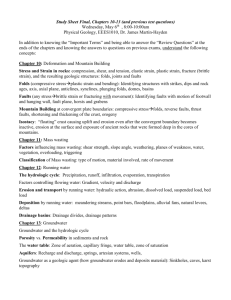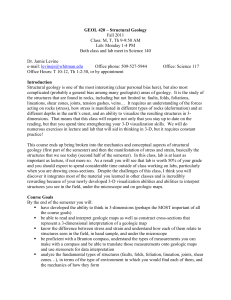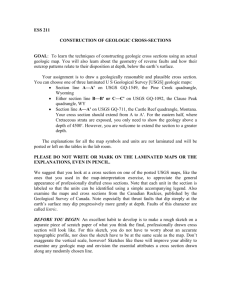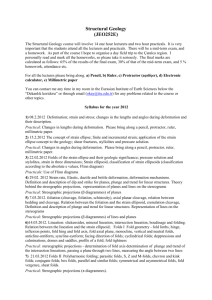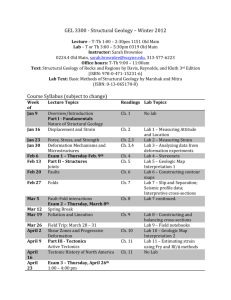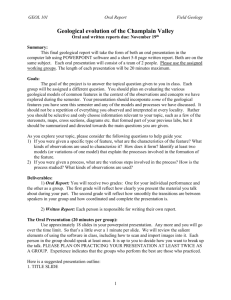01:460:407 - Rutgers University :: Department of Earth and
advertisement
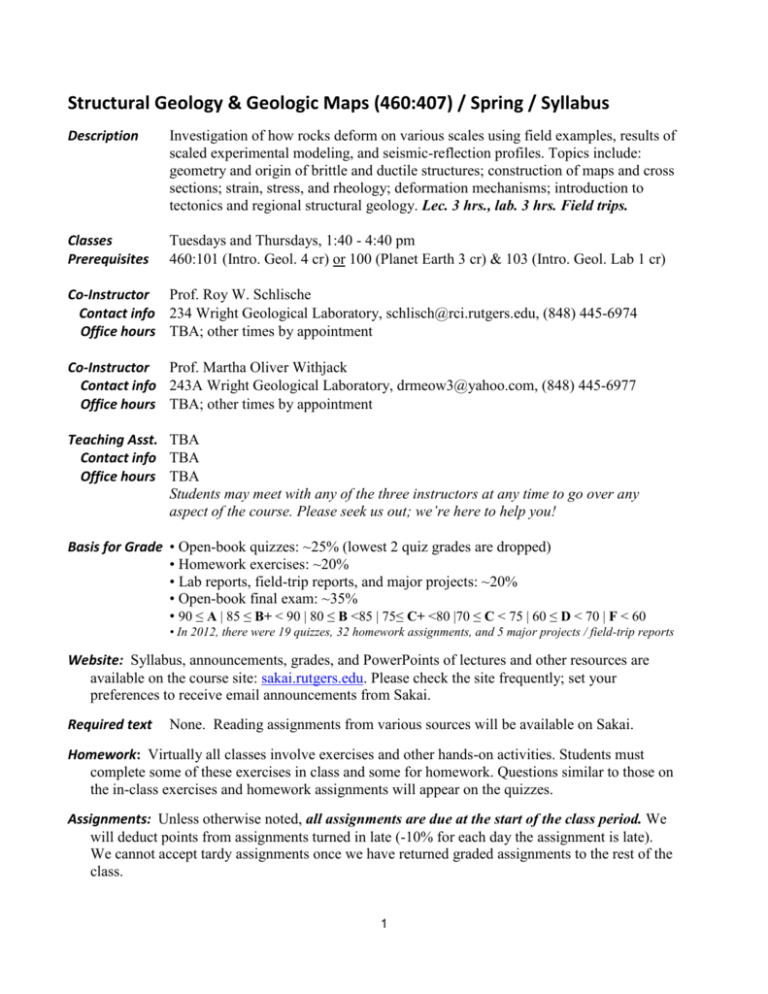
Structural Geology & Geologic Maps (460:407) / Spring / Syllabus Description Investigation of how rocks deform on various scales using field examples, results of scaled experimental modeling, and seismic-reflection profiles. Topics include: geometry and origin of brittle and ductile structures; construction of maps and cross sections; strain, stress, and rheology; deformation mechanisms; introduction to tectonics and regional structural geology. Lec. 3 hrs., lab. 3 hrs. Field trips. Classes Prerequisites Tuesdays and Thursdays, 1:40 - 4:40 pm 460:101 (Intro. Geol. 4 cr) or 100 (Planet Earth 3 cr) & 103 (Intro. Geol. Lab 1 cr) Co-Instructor Prof. Roy W. Schlische Contact info 234 Wright Geological Laboratory, schlisch@rci.rutgers.edu, (848) 445-6974 Office hours TBA; other times by appointment Co-Instructor Prof. Martha Oliver Withjack Contact info 243A Wright Geological Laboratory, drmeow3@yahoo.com, (848) 445-6977 Office hours TBA; other times by appointment Teaching Asst. TBA Contact info TBA Office hours TBA Students may meet with any of the three instructors at any time to go over any aspect of the course. Please seek us out; we’re here to help you! Basis for Grade • Open-book quizzes: ~25% (lowest 2 quiz grades are dropped) • Homework exercises: ~20% • Lab reports, field-trip reports, and major projects: ~20% • Open-book final exam: ~35% • 90 ≤ A | 85 ≤ B+ < 90 | 80 ≤ B <85 | 75≤ C+ <80 |70 ≤ C < 75 | 60 ≤ D < 70 | F < 60 • In 2012, there were 19 quizzes, 32 homework assignments, and 5 major projects / field-trip reports Website: Syllabus, announcements, grades, and PowerPoints of lectures and other resources are available on the course site: sakai.rutgers.edu. Please check the site frequently; set your preferences to receive email announcements from Sakai. Required text None. Reading assignments from various sources will be available on Sakai. Homework: Virtually all classes involve exercises and other hands-on activities. Students must complete some of these exercises in class and some for homework. Questions similar to those on the in-class exercises and homework assignments will appear on the quizzes. Assignments: Unless otherwise noted, all assignments are due at the start of the class period. We will deduct points from assignments turned in late (-10% for each day the assignment is late). We cannot accept tardy assignments once we have returned graded assignments to the rest of the class. 1 Syllabus Structural Geology: Spring For ALL assignments: (1) All pages must be stapled or bound with a paper clip. (2) Your name must appear on each page. (3) If the assignment involves multiple exercises, the exercises must be properly numbered and submitted in the proper sequence. (4) For numerical or graphical problems, you must show all your work, the final answer should be boxed, and all numerical answers must be accompanied by the proper units (e.g., 35 meters, 26°, 45 MPa). For ALL exercises requiring written answers: All answers must be typed and double-spaced. You must use complete sentences, and give the reason for your answer. Grammar, spelling, and writing style will be graded along with content. Academic Integrity: Our department endorses a zero-tolerance cheating policy. For homework assignments, we expect that students will work on these exercises independently. Copying of another student’s homework is considered plagiarism. Absences and tardiness: Students are expected to attend all classes (including the field trips) and arrive to class on time (1:40 pm). | Almost all classes will begin with a quiz. Students who arrive late may work on the quiz, but may not have enough time to complete the quiz. Students who miss a quiz may NOT make up the quiz; however, we will drop the lowest two quiz grades. | Absent students may email assignments to instructors (to avoid late penalties), but will need to provide hard copies ASAP and no later than next class period. | Absent students should contact all three instructors at the earliest possible time to discuss the reason for the absence and how the class work can be made up. | Leaving class and returning is rude and disruptive, so please take care of business before class begins and/or during the breaks. Electronic devices: We require that you turn off and put away all electronic devices (phones, laptops, MP3 players, etc.) once the class begins. You may not use any electronic devices during the quizzes and final exam. Field Trips: Three required field trips will take place in April (see next page for exact dates and times). Attendance is mandatory. Written reports and/or exercises related to the trips will be due following each trip. Please make arrangements now so that you can attend all the trips in April. Supplies: • 3-ring binder* (for holding handouts, notes, assignments, etc.; it is imperative that you keep this notebook organized) • Colored pencils with erasers (5-10 colors; red, blue, green, yellow, orange, purple, etc.) * • Protractor* (smaller is better) • Metric ruler* • Calculator* • For Stereonet exercises: tracing paper, sturdy cardboard (~8.5” x 11”), thumbtack *Bring these supplies to each class. List of topics and activities • Introduction to course and basics of deformation • Faults: Recognition and classification • Laboratory: Experimental model of extensional faulting • Attitude; strike & dip; types of contacts • Thickness, outcrop width, depth • Cross sections, vertical exaggeration • Faults: Slip vs. separation, strain, terminations 2 Syllabus Structural Geology: Spring • Block diagrams: Faults • Cross sections: Faults • Joints and veins • Stress and Mohr circles • Fracture mechanics • Folds: Geometry & classification • Block diagrams, maps, cross sections: Folds • Folding processes and mechanisms • Timing of deformation • Team project: Interpretation of seismic profiles; classification of faults and folds; interpretation of geologic history • Foliations & lineations • Shear zones and kinematic indicators • Stereonets 1: Plotting techniques • Deformation mechanisms • Stereonets 2: Attitude problems and rotations • Strain • Rheology (stress-strain relationships) • Contour maps 1: Rule of V’s, structure-contour and isopach maps • Contour maps 2: Preparing structure-contour maps from seismic data • Structural styles • Seismic workstation project: Interpretation of 3D seismic data • Brunton compass • Application exercise: Hydrocarbon systems • Field trip 1: Newark basin—3rd Saturday in April , 9:30 am - 4:30 pm • Field trip 2: Valley & Ridge—4th Saturday in April, 9:30 am - 4:30 pm • Rain date: Sunday, 4/27, 9:30 am – 4:30 pm • Field trip 3: Newfoundland folds—last Tuesday in April, 12:00 - 4:40 pm • Field-trip review—Geologic history of New Jersey & Surrounding Region • Final exam (open notebook): TBA; exam must be taken during scheduled time Structural Geology: Learning Goals General learning goals. During this course, students will: • Acquire the necessary vocabulary to read about structural geology • Apply scientific thinking to problems in structural geology • Gain proficiency in spatial visualization skills • Gain proficiency in making observations and measurements using laboratory, field, and seismic data and in presenting those observations in well-written, succinct reports • Develop interpersonal skills by working on team projects Specific learning goals. By the end of this course, students should be able to: • Recognize what features constitute deformation • Understand the distinction between deformational behavior and deformation mechanisms 3 Syllabus Structural Geology: Spring • Understand the characteristics of elastic, brittle and plastic deformation mechanisms and brittle and ductile deformational behavior • Understand fault nomenclature (hanging-wall vs. footwall, dip-slip vs. strike-slip displacement) and how to recognize faults (offsets, repetition and omission of strata) in map view and cross section • Use slickensides and slickenlines to determine the movement sense on a fault • Understand the classification of faults based on sense of slip, geometry, and basement involvement • Understand the symbols used to represent faults on maps and cross sections • Use strike and dip to describe the attitude of planar structures • Understand the distinction between azimuth and bearing • Understand the rationale for scaled experimental modeling and how normal faults develop in simple models of extension • Recognize and determine the attitudes of lithologic, fault, and unconformable contacts in map view and cross section • Understand the relationship among thickness, depth, and outcrop width • Construct a geologic cross section, make corrections for apparent dip, and calculate vertical exaggeration • Understand the distinction between fault slip and separation • Understand how fault attitude, bedding attitude, and fault slip affect separation • Understand how faults terminate, the relationship between fault length and fault displacement, and how to calculate fault-related strain • Construct cross sections of geologic maps containing faults • Understand the similarities and differences among faults, joints, and veins • Understand the significance of plumose markings and vein fibers • Understand the distinction between force and stress and how to calculate stress as a function of depth below the Earth’s surface • Understand how to read and plot Mohr-circle representations of stress states • Understand how to use the results of experimental fracture mechanics plotted on Mohr diagrams to define the conditions under which faults and extension fractures develop • Understand Anderson’s theory, which describes the relationship between the orientations of the three principal stresses and the three main classes of faults (normal, thrust, strike-slip) • Understand how to use fault attitude (or attitude of intrusions and joints) to determine the orientation of the three principal stresses • Understand the conditions under which preexisting weaknesses undergo frictional reactivation • Understand how pore-fluid pressure affects normal and shear stresses and the likelihood of fracturing • Understand the terms used to describe the geometry of folds • Understand how the trend and plunge of the fold hinge line and the strike and dip of the axial plane affect the geometry of folds in map view and cross section • Understand the distinction among shear folding, flexural-slip folding, and flexural-shear folding • Understand the distinction between buckling and bending • Recognize detachment, fault-bend, fault-propagation, and fault-displacement folds • Understand the symbols used to represent folds on geologic maps and cross sections • Construct cross sections of geologic maps containing folds 4 Syllabus Structural Geology: Spring • Understand how to use cross-cutting relationships, the presence or absence of growth beds, and the presence of unconformities to constrain the timing of deformation • Understand how to plot strike & dip, trend & plunge, and rake on a stereonet • Read the strike & dip, trend & plunge, and rake from a stereoplot • Use stereonets to solve structural problems involving apparent dip, three-point problems, and line of intersection and bisector of two non-parallel planes • Understand how vertical-axis and horizontal-axis rotations affect stereoplots of planes and lines; understand how to use rotations to undeform structures and to determine the original attitudes of sedimentary structures and geologic structures located below unconformities • Understand the distinction between foliations and lineations and the processes that produce them • Understand the relationship between folding and foliations, and how to use this to determine whether bedding is upright or overturned • Understand how competence affects cleavage spacing, cleavage fanning geometry, and the geometry of boudins • Understand the different rocks that form in brittle, brittle-ductile and ductile shear zones • Use small-scale kinematic indicators to determine sense of shear in the absence of offset markers and slickenlines • Understand the important role of vacancies and dislocations for accommodating plastic deformation • Associate microstructures with specific deformation mechanisms • Understand the distinction between deformation and strain • Understand how to measure strain (elongation, stretch, shear strain, etc.) • Understand how the strain ellipse is a visual representation of the magnitude and direction of the principal strains • Understand the distinction between irrotational and rotational strain and between pure shear and simple shear • Understand how to use deformed fossils and faulted and folded beds to calculate strain • Understand how to read contour maps and how topography influences the geometry of planar structures (rule of V’s) • Understand the distinction among structure-contour, isopach, and isochore maps • Understand how folds and faults affect the geometry of contours on structure-contour maps • Construct a profile from a structure-contour / isopach / isochore map • Construct structure-contour maps from 3D seismic data • Understand the similarities and differences among elastic, viscous, plastic and other rheologies • Understand how pressure, temperature, strain rate, and pore-fluid pressure influence strength and deformational behavior • Understand how stress varies as a function of depth, and how temperature influences the depth of the brittle-ductile transition • Understand the implications of strength versus depth plots for plate tectonics • Understand the deformation patterns associated with various structural styles (salt/shale tectonics, detached extension and shortening, and basement-involved extension, shortening, strike-slip and inversion) • Use a Brunton compass to sight a bearing and inclination as well as to measure strike and dip, trend and plunge, and rake 5 Syllabus Structural Geology: Spring • Understand the tectonic history of New Jersey and adjacent areas (assembly and breakup of supercontinents) and the expression of this history in outcrop-scale structures • Synthesize knowledge of structural geology and apply it to hydrocarbon exploration (i.e., source rock maturation, migration, and entrapment) Assessment of learning will consist of: • Frequent quizzes and homework assignments • Detailed comments on first and second drafts of a written report • Pre- and post-course assessments • Final, comprehensive examination Policy on Classroom Etiquette Department of Earth & Planetary Sciences, Rutgers University, Piscataway, NJ The Department of Earth & Planetary Sciences is committed to teaching excellence. We demand that instructors (Professors, Lecturers, and Teaching Assistants) AND students display appropriate respect and consideration for each other. Instructors should try to infuse students with an enthusiastic appreciation of Geological Sciences, be well prepared for class, provide students with clear goals and expectations, listen carefully to student questions and comments, and conscientiously evaluate students' work. Students are expected to attend the scheduled classes and to behave courteously in class. Together, instructors and students will maintain an environment of openness and civility that encourages and honors the intellectual achievement represented by the discipline of Geological Sciences. • Exams: No unexcused make-up exams will be given. Those with valid excuses will be allowed to take exams in a method determined by the instructor. To be valid, an excuse has to be obtained from the instructor prior to the exam being missed. It is a responsibility of the student to communicate with an instructor, and to keep a proof of such communication. Rare cases of extreme emergency preventing timely communication are to be discussed with the Undergraduate Director and/or Department Chair. • Attendance: Students are expected to attend all classes; if you expect to miss one or two classes, please use the University absence reporting website https://sims.rutgers.edu/ssra to indicate the date and reason for your absence. An email is automatically sent to the instructor. [Course policy is clearly spelled out on page 2.] • Tardiness and Leaving Class Early: Students should try to not schedule courses on different campuses in adjacent periods. We recognize that some tardiness is inevitable; HOWEVER, habitually arriving in class late and departing early (or departing and returning) is disruptive and rude. We ask that you make every effort possible to get to class on time and, once there, STAY. • Personal Conversation: It is rude and disruptive to engage in personal conversation during class. Students who persist in this disruptive behavior may be asked to leave the class and may be penalized as absent. Refusal to leave class once requested will result in disciplinary action at the Dean's level. Electronic devices should be turned off and put away during class. • Academic Integrity: Our department fully endorses a no-tolerance cheating and plagiarism policy. If you are caught cheating, the instructor may fail you and request disciplinary action. • Your Rights: We are all human and instructors and students both make mistakes. If you feel that you have been treated unfairly, contact the undergraduate director, Dr. Vadim Levin (vlevin@eps.rutgers.edu) or the department chair, Dr. Carl Swisher (cswish@eps.rutgers.edu). 6
